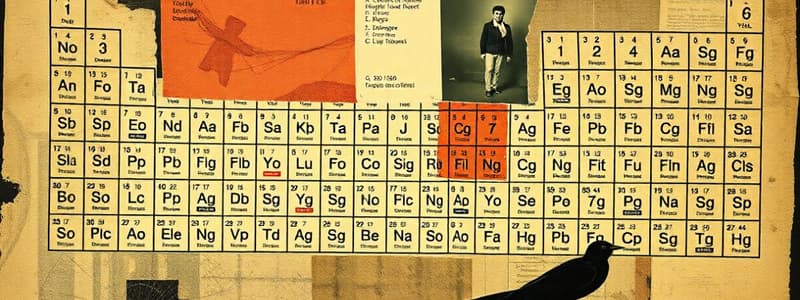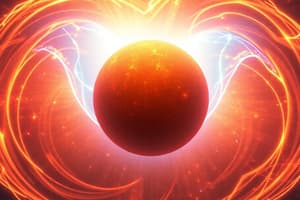Podcast
Questions and Answers
What was the primary basis for Mendeleev's original organization of the periodic table?
What was the primary basis for Mendeleev's original organization of the periodic table?
- Electron affinity
- Chemical properties
- Atomic mass (correct)
- Atomic number
Which scientist contributed to the development of the concept of atomic number?
Which scientist contributed to the development of the concept of atomic number?
- Lothar Meyer
- Ernest Rutherford
- Dmitri Mendeleev
- Henry Moseley (correct)
What does the term 'periodicity' refer to in the context of the periodic table?
What does the term 'periodicity' refer to in the context of the periodic table?
- The atomic mass of elements
- The repetitive pattern of a property based on atomic number (correct)
- The arrangement of elements by chemical properties
- The ionization energy of elements
What is a fundamental property that influences many trends within the periodic table?
What is a fundamental property that influences many trends within the periodic table?
Which of the following properties is NOT discussed as a periodic property in this chapter?
Which of the following properties is NOT discussed as a periodic property in this chapter?
How is the effective nuclear charge (Zeff) calculated?
How is the effective nuclear charge (Zeff) calculated?
Which of the following trends describes Zeff as you move across a period in the periodic table?
Which of the following trends describes Zeff as you move across a period in the periodic table?
Which element is predicted to have the smallest effective nuclear charge (Zeff) among Cl, O, N, and Ca?
Which element is predicted to have the smallest effective nuclear charge (Zeff) among Cl, O, N, and Ca?
What defines the valence electrons of an element?
What defines the valence electrons of an element?
In which situation would you not count electrons as valence electrons?
In which situation would you not count electrons as valence electrons?
Flashcards
Periodic Table
Periodic Table
A table organizing elements based on repeating patterns of properties.
Mendeleev
Mendeleev
Chemist who contributed significantly to the periodic table, predicting missing elements.
Atomic mass
Atomic mass
The mass of an atom, fundamental property used in early periodic tables.
Atomic Number
Atomic Number
Signup and view all the flashcards
Periodicity
Periodicity
Signup and view all the flashcards
Effective Nuclear Charge
Effective Nuclear Charge
Signup and view all the flashcards
Effective Nuclear Charge
Effective Nuclear Charge
Signup and view all the flashcards
Zeff increases across a period
Zeff increases across a period
Signup and view all the flashcards
Zeff decreases down a group
Zeff decreases down a group
Signup and view all the flashcards
Valence Electrons
Valence Electrons
Signup and view all the flashcards
Shielding Effect
Shielding Effect
Signup and view all the flashcards
Screening Constant
Screening Constant
Signup and view all the flashcards
Study Notes
Periodic Properties of the Elements
- Mendeleev and Meyer independently developed the periodic table, organizing elements based on atomic mass.
- The table's structure revealed periodic trends in element properties.
- Mendeleev used chemical properties to predict the existence and properties of undiscovered elements.
- His prediction of Germanium, with properties remarkably similar to what was later observed, was crucial to validating his approach.
- Moseley's concept of atomic number (number of protons) experimentally validated the periodic structure.
- Periodicity is the repeating pattern of properties with increasing atomic number. Key properties are atomic/ionic size, ionization energy, electron affinity, and group trends.
Effective Nuclear Charge
- Effective nuclear charge (Zeff) is the net positive charge experienced by a valence electron.
- It accounts for the attractive force of the nucleus and the shielding effect of inner electrons.
- Zeff increases across a period due to increased nuclear charge with little shielding effect change.
- Zeff decreases down a group due to increasing distance of valence electrons from the nucleus, and increased shielding from inner electrons.
Atomic Size
- Atomic radius is half the distance between the nuclei of two bonded atoms.
- Atomic radii generally decrease across a period and increase down a group, reflecting the interplay of increasing effective nuclear charge and increasing electron shells.
Ionic Size
- Ions' sizes differ from their parent atoms: Cations are smaller due to the loss of outermost electrons. Anions are larger due to gained electrons, leading to increased electron-electron repulsions.
- Isoelectronic series exhibit decreasing ionic size with increasing nuclear charge, a direct consequence of stronger nuclear attraction.
Ionization Energy
- Ionization energy (I) is the energy needed to remove an electron from a gaseous atom or ion.
- Removing successive electrons requires increasingly more energy (first, second, and so on).
- Ionization energy generally increases across a period and decreases down a group, reflecting the influence of effective nuclear charge and atomic size.
- Irregularities exist due to electron configuration. The closer an electron is to the nucleus, the more energy required to remove. The further away it is from the nucleus, the less energy required to remove.
Electron Affinity
- Electron affinity (EA) is the energy change when a gaseous atom gains an electron.
- EA is often negative because the gain of an electron often releases energy (exothermic).
- Across a period, EA generally increases.
- Certain groups show exceptions because of full and half-filled electron sublevels.
Metals, Nonmetals, and Metalloids
- Metals are generally found on the left side of the periodic table, are good conductors, form cations, and have low ionization energies.
- Nonmetals are found mostly on the right side of the periodic table, have high electronegativity, form anions, and have poor conductivity.
- Metalloids exhibit properties of both metals and nonmetals, often acting as semiconductors.
Group Trends
- Key properties of specific groups are discussed, such as alkali metals (highly reactive), alkaline earth metals (less reactive), halogens (highly reactive nonmetals), and noble gases (inert).
- Specific traits, trends, and chemical behaviors are summarized for each group.
Studying That Suits You
Use AI to generate personalized quizzes and flashcards to suit your learning preferences.




